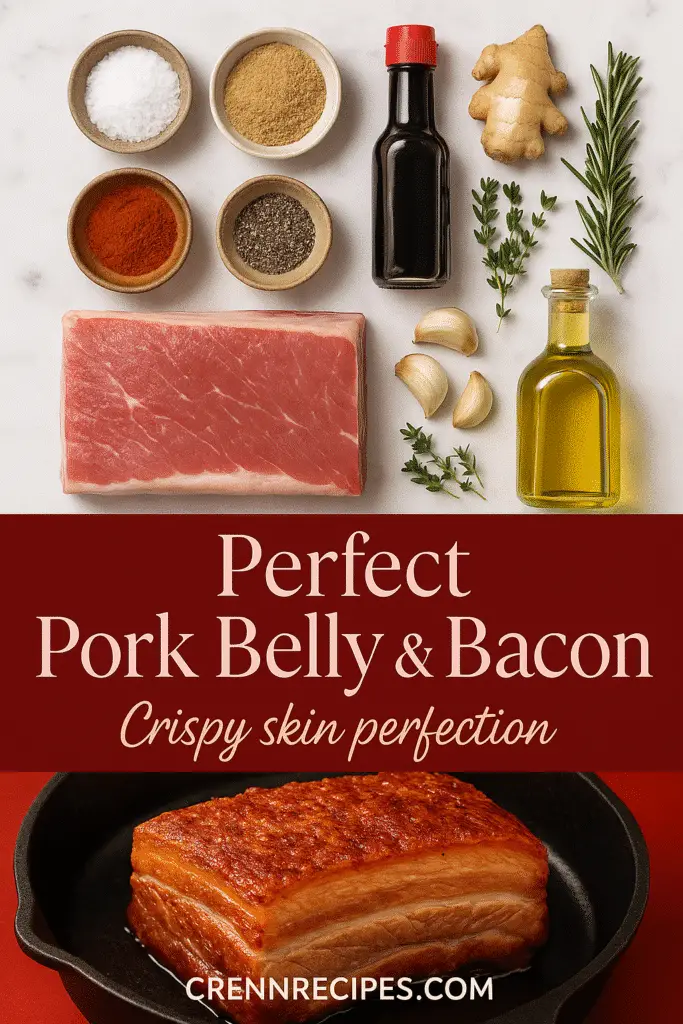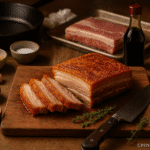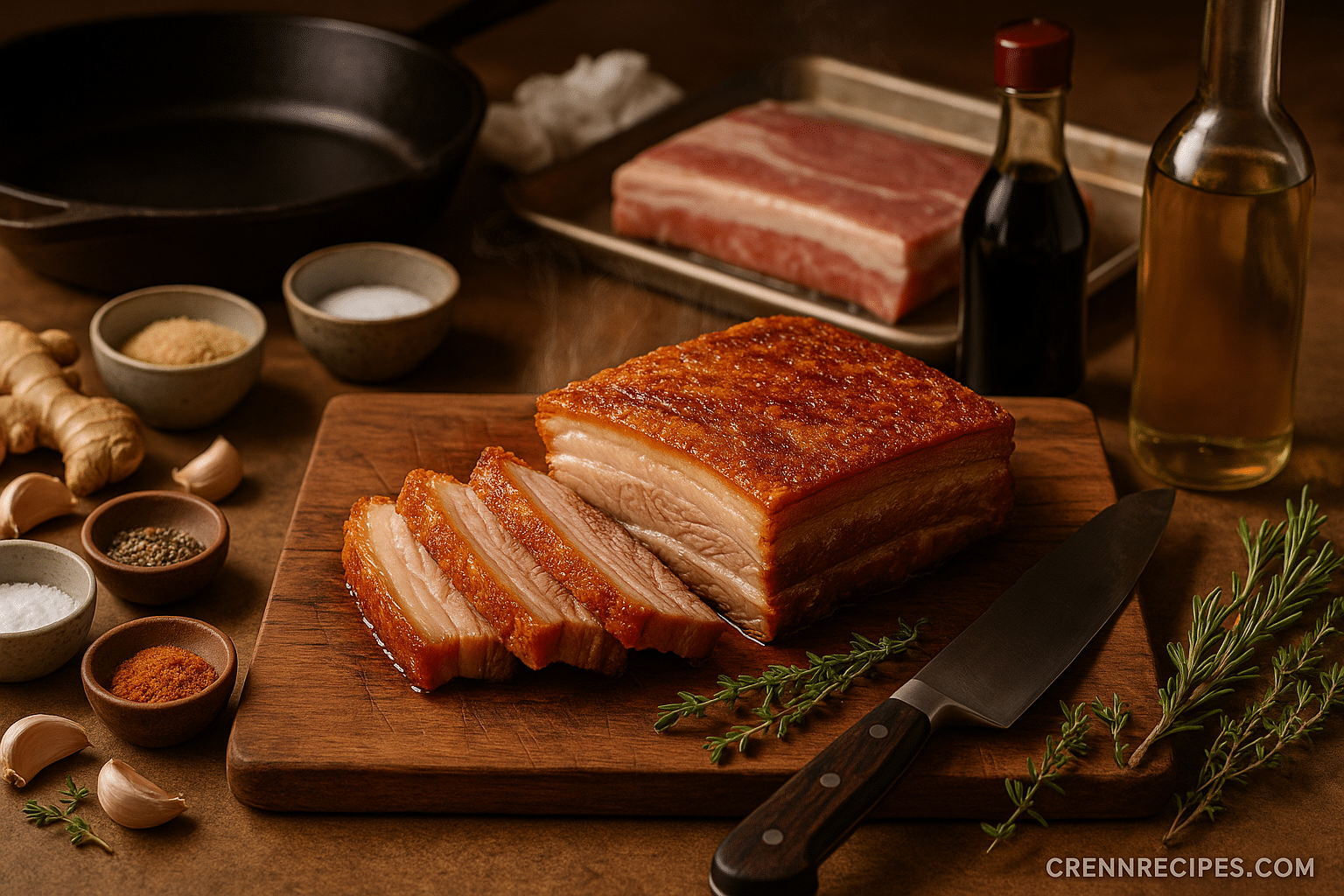It might seem hard to cook delicious pork belly and bacon at home. But, with the right steps, anyone can do it. I’ll show you how to turn simple meat into a dish that will wow your loved ones.
Knowing the difference between pork belly and bacon is key. Pork belly is fresh meat from the pig’s belly. Bacon, on the other hand, needs special preparation to get its unique taste and texture.
I’ve spent a lot of time in my kitchen trying to make the perfect pork belly and bacon. I’ve found that using top-quality meat and learning cooking tricks are essential. This guide is for anyone who loves cooking or wants to get better at it.
Key Takeaways
- Understand the fundamental differences between pork belly and bacon
- Learn essential techniques for preparing high-quality cured meat
- Discover how to select the best cuts for your recipes
- Master temperature control and seasoning
- Develop confidence in home meat preparation
Introduction to Pork Belly and Bacon
Exploring heritage breed pork opens up a world of flavors and traditions. Pork belly and bacon are two cuts that chefs and food lovers have cherished for years. They are more than just meat to prepare; they are a showcase of culinary craftsmanship.
Understanding the Cuts of Pork
Pork cuts vary greatly. Pork belly is located on the pig’s underside, blending meat and fat. Here’s why these cuts stand out:
- Pork belly is the raw, unprocessed slab of meat
- Bacon comes from pork belly but is cured and smoked
- Charcuterie experts value these cuts for their rich flavors
The Flavor Profiles of Pork Belly and Bacon
Smoked bacon adds a deep, salty-sweet taste to dishes. Heritage breed pork enhances this experience with even more complex flavors. Each cut has its own story, from the subtle richness of pork belly to the bold taste of artisanal bacon.
Health Benefits and Considerations
These cuts are tasty but need careful eating. Pork belly is high in fat, so it’s important to control portions. Creative cooking methods can balance nutrition with taste. Choosing lean cuts and preparing them carefully can make these indulgences healthier.
Cooking Techniques for Pork Belly
Mastering pork belly dishes means knowing the right cooking techniques. I’ll share my proven methods for turning this rich cut into a mouthwatering meal. It will impress even the most discerning food lovers.
Slow-Roasting for Ultimate Tenderness
Slow-roasting is key to tender pork belly. My preferred method is a two-stage roasting process:
- Start at high heat (450°F) for 30 minutes to crisp the skin
- Reduce temperature to 275°F for an additional hour
- Let the meat rest for 15 minutes before serving
Secrets to Crispy Skin Perfection
Creating the perfect crispy skin for pork belly dishes requires careful preparation. I recommend these key techniques:
- Pat the skin completely dry with paper towels
- Score the skin in a diamond pattern
- Rub generously with salt to draw out moisture
Flavor Explosion: Marinades and Rubs
Pork smoking and marinading can elevate your pork belly to new culinary heights. Check out my favorite flavor combinations:
| Flavor Profile | Key Ingredients | Recommended Cooking Method |
|---|---|---|
| Asian-Inspired | Soy sauce, ginger, garlic | Slow roasting |
| Smoky BBQ | Paprika, brown sugar, chili powder | Pork smoking |
| Herbal Mediterranean | Rosemary, thyme, olive oil | Oven roasting |
Pro tip: Always let your pork belly rest after cooking. This ensures maximum juiciness and flavor distribution. Your patience will be rewarded with a truly spectacular dish!

Mastering Bacon Preparation
Making perfect bacon starts with knowing how to cure pork. It takes patience and precision. First, pick high-quality pork belly. Then, cure it carefully to turn it into a tasty treat.
Choosing the right bacon is key. Different cuts have unique flavors and textures. Try thick-cut and applewood-smoked bacons. Think about the meat’s fat and marbling for a richer taste.
Essential Curing Techniques
Curing pork is both an art and science. I use a seven-day cure with kosher salt, brown sugar, and spices. Keep the temperature steady for safety and flavor. Smoking at 165°F for six hours adds a smoky taste.
Cooking Methods Explored
Pan-frying and oven-baking have their perks. Oven-baking is cleaner and more consistent. Use a sheet pan for easy cooking and cleanup. Pan-frying gives crispy edges and more control.
Creative Bacon Applications
Use leftover bacon in new ways. Add it to salads, soups, or baked goods. My top trick is to use bacon fat for cooking. It makes veggies and eggs taste richer.

FAQ
What’s the difference between pork belly and bacon?
Pork belly is a cut from the pig’s underside, not cured or smoked. Bacon is cured and smoked pork belly. Pork belly is great for cooking, while bacon is ready to use in dishes.
How do I choose the best pork belly for cooking?
Choose heritage breed pork with lots of marbling and fat. It should look pink and fresh. Opt for pasture-raised pork for better flavor and texture. The fat should be white, not yellow.
What’s the best way to achieve crispy pork belly skin?
Dry the skin with paper towels first. Score it in a diamond pattern without cutting the meat. Use salt to dry it more. Cook at 425°F to crisp the skin.
Is homemade bacon difficult to make?
Making homemade bacon takes patience, but it’s doable. You need pork belly, curing salt, spices, and a smoker or oven. Cure the meat for 5-7 days, then smoke or roast it.
How long can I store cured pork belly or homemade bacon?
Cured bacon lasts up to two weeks in the fridge. Vacuum sealing can extend it to a month. Keep it in the coldest part of the fridge and check for spoilage.
What are the health considerations when eating pork belly and bacon?
Pork belly and bacon are high in fat and sodium. Eat them in moderation. Choose pasture-raised options and leaner cuts if you’re watching your fat intake.
Can I make bacon from different types of pork?
Bacon is usually made from pork belly, but you can try other cuts. Heritage breeds like Berkshire or Duroc can add unique flavors to your bacon.
What’s the best cooking method for pork belly?
Slow-roasting is the best way to cook pork belly. Start at 275°F for hours, then finish at a high temperature. This method makes the meat tender and the skin crispy.

Pork Belly and Bacon: Ultimate Guide to Perfect Home Cooking
- Total Time: 120 minutes
- Yield: 6 servings 1x
Description
Master the art of cooking perfect pork belly and bacon at home with professional techniques. Learn essential curing, roasting, and smoking methods for restaurant-quality results that will impress your family and friends.
Ingredients
2 lbs fresh pork belly, skin-on
1/4 cup kosher salt
2 tablespoons brown sugar
1 tablespoon black pepper
1 tablespoon paprika
2 tablespoons soy sauce
2 inches fresh ginger, sliced
4 garlic cloves, minced
3 sprigs fresh rosemary
2 sprigs fresh thyme
2 tablespoons olive oil
Instructions
1. Pat pork belly skin completely dry with paper towels
2. Score skin in diamond pattern without cutting into meat
3. Rub generously with kosher salt mixture and let cure 24 hours
4. Preheat oven to 450°F for initial high-heat searing
5. Roast at high heat for 30 minutes to crisp skin
6. Reduce temperature to 275°F and continue roasting 1 hour
7. Check internal temperature reaches 165°F for food safety
8. Rest meat for 15 minutes before slicing and serving
Notes
For best results, choose heritage breed pork with good marbling
Patience during curing process creates superior flavor development
Always let meat rest after cooking for maximum juiciness
Store leftover bacon in refrigerator up to 2 weeks
Bacon fat can be saved for cooking vegetables and eggs
- Prep Time: 30 minutes
- Cook Time: 90 minutes
- Category: Main Course
- Method: Roasting
- Cuisine: American
Nutrition
- Serving Size: 4 oz
- Calories: 380
- Sugar: 2g
- Sodium: 890mg
- Fat: 32g
- Saturated Fat: 12g
- Unsaturated Fat: 18g
- Trans Fat: 0g
- Carbohydrates: 3g
- Fiber: 0g
- Protein: 22g
- Cholesterol: 85mg

